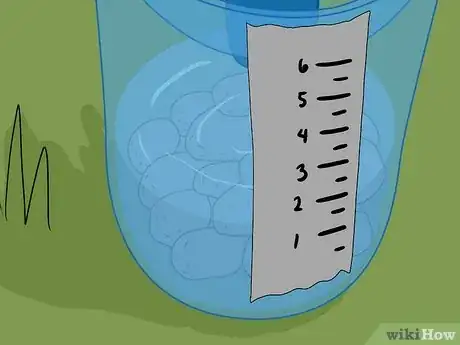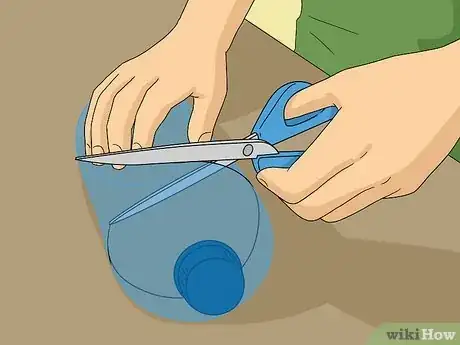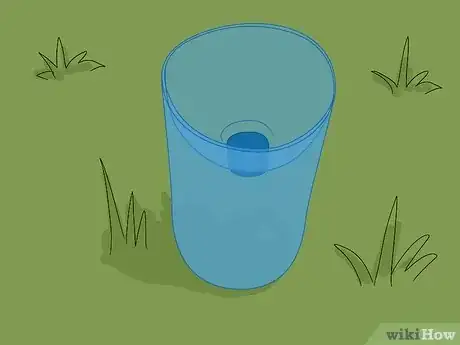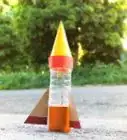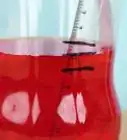This article was co-authored by Meredith Juncker, PhD. Meredith Juncker is a PhD candidate in Biochemistry and Molecular Biology at Louisiana State University Health Sciences Center. Her studies are focused on proteins and neurodegenerative diseases.
wikiHow marks an article as reader-approved once it receives enough positive feedback. This article has 18 testimonials from our readers, earning it our reader-approved status.
This article has been viewed 404,311 times.
If you'd like to keep track of how much rainfall you're getting, you can either buy a rain gauge or make one for yourself. You only need a few simple materials and a small amount of time. Use the gauge to compare the rainfall day to day, week to week, or even month to month.
Steps
Creating a Rain Gauge With Built In Measurement
-
1Cut the top off of the bottle. Use a pair of scissors to carefully cut the top of the bottle off. Cut just beneath where the bottle begins to narrow. A plastic soda bottle works best. Be sure to remove the paper label completely.[1]
- Parental supervision may be necessary for younger children when cutting the bottle.
-
2Place pebbles in the bottom. Pour in the pebbles in the bottom of the bottle. Soda bottles are never flat. Pour in the pebbles to even out the bottom and to keep the gauge from tipping over if it’s windy or the downpour is extremely heavy.[2]Advertisement
-
3Turn the top of the bottle into a funnel. Remove the cap from the top of the bottle and turn it upside down. Place it upside down on the bottom part of the bottle so that the top is pointing downward. Secure the funnel in place by lining up the cut edges and taping the two halves together.[3]
- Make sure that the top half is firmly held in place, and that there aren't any gaps between the two pieces of your gauge.
-
4Create your measuring line. Cut a long piece of duct tape and place it on the side of the gauge so that it creates a straight vertical line from the bottom of the bottle to the top. Take a marker and a straightedge to draw a horizontal line just above the pebbles. This is the bottom of the gauge.
- Use duct tape for it’s strong adhesive properties. Masking tape, or other forms of tape, may come loose when soaking wet.
-
5Mark off half-centimeter or half-inch intervals. Take a ruler and place it against the tape so that the 0 lines up with the bottom line you have marked off. Use a marker to mark off every half-centimeter or half-inch along the tape until you get to the top. Label the centimetres or inches from the top to the bottom. You want to be sure that your measurements will be easy to read throughout the duration of the experiment.[4]
- Every half interval does not need to be labeled. Label every other mark by beginning with the second mark as 1 inch or cm. The marks in-between each label are a half measurement. Make sure to wait until your marker dries on the tape before placing your gauge in the rain. Do not use washable markers or apply markings while in the rain. If you have to reapply new tape or new markings midway through the experiment, your results may be considered inaccurate.
- You may use any unit of measurement your experiment calls for. You can mark off every quarter-inch, eighth-inch, or centimeter.
-
6Place the gauge at an optimal location. Set your gauge on a level surface. Make sure it isn’t obstructed by any branches or in the way of people walking by. Pour some water in the bottom until it reaches the 0 mark and then you’re ready to collect.[5]
- You may also use coloured jelly instead of water to give yourself a reference point of where to start measuring. Use jelly or oil rather than another liquid as those may dissolve and mix into the water, ruining your measurements. These bottles are not evenly shaped on the bottom so you must account for this by establishing your starting point.
- Make sure that the gauge is in a protected area. You want to ensure that there’s no disturbance from wind, debris, or anything else that could block or prevent rain from entering, like a branch or powerline.
-
7Pay attention to the weather. Check the forecast for rain. Check your gauge exactly 24 hours later to see how high the water has risen. Now you know how much rain has fallen.[6]
- Check how closely your measurements compare to official ones by checking the news or online for the rainfall measurements of your area for the day.
-
8Repeat your measurements. You can continue measuring for 7 - 14 days or until your curiosity has stopped. If this is an experiment assigned by your teacher, make sure you follow every perimeter and take measurements until the experiment tells you to stop.[7]
- Try to take your measurements at roughly the same time so that you get a 24-hour reading. Then, dump the rain out between each measurement to start a new measurement for the next day.
Using a Measuring Cylinder
-
1Get a plastic bottle. Find an empty two litre plastic bottle from your recyclables. You can also buy a two litre bottle of soda from your local supermarket or corner store and empty it out.[8] Make sure that it is completely empty and dry of its contents before using.
-
2
-
3Invert the top of the bottle. Remove the top of the bottle and invert it to fit upside down over the bottom of the bottle like a funnel. Use paperclips to hold the two halves snugly together. If there is a heavy downpour, you will need to make sure your rain gauge does not come apart.
-
4Place your rain gauge. Find an adequate location to collect rain. You don’t want to place the gauge close to a high traffic area where it could get knocked over. Avoid placing it near buildings or trees where a change in wind direction could prevent any rain from falling into the gauge.
- Keep it upright by placing it in a bucket or container. You may also dig a hole for the gauge to stand about halfway in.
-
5Measure your findings. Remove the gauge from its location at the prescribed time every day and take your measurement. Pour the collected rain into a measuring cylinder.[10] Be careful not to spill any water.
- For example, your measuring cylinder may be measuring in cm so if you have collected rain for one week and the water you pour in from your rain gauge reaches the 10 cm mark on your measuring cylinder, you can ascertain that roughly 10 cm of rain has fallen during the week.
- Compare your daily measurements. Using a pen and paper, record your findings every day at the exact same time of day to give you an accurate comparison.
-
6Account for an uneven bottle. Most soda bottles are uneven at the bottom. Before you measure any rain, use a ruler to measure how much liquid fills the uneven bottom. Subtract this small amount from your final findings.
-
7Analyze your results. Compare the amount of rain you gather to the length of time it takes to reach this amount. For example, how many days will it take to rain 15 cm. You can also compare the rainfall from month to month, week to week, or day to day. You may even graph your results to see the changes as the season progresses into the next.
- You may also compare your findings with the wind speed, wind direction, or air pressure. Be sure to always replace your gauge at the same location.
Expert Q&A
Did you know you can get expert answers for this article?
Unlock expert answers by supporting wikiHow
-
QuestionDoes diameter matter?
 Meredith Juncker, PhDMeredith Juncker is a PhD candidate in Biochemistry and Molecular Biology at Louisiana State University Health Sciences Center. Her studies are focused on proteins and neurodegenerative diseases.
Meredith Juncker, PhDMeredith Juncker is a PhD candidate in Biochemistry and Molecular Biology at Louisiana State University Health Sciences Center. Her studies are focused on proteins and neurodegenerative diseases.
Scientific Researcher
-
QuestionWhat do I do if it leaks?
 Community AnswerIf the rain gauge leaks you can always re-make it. If you do not want to redo the whole rain gauge, you can simply dump the water out and tape the parts that leaked using waterproof tape.
Community AnswerIf the rain gauge leaks you can always re-make it. If you do not want to redo the whole rain gauge, you can simply dump the water out and tape the parts that leaked using waterproof tape. -
QuestionCan I heat the bottom of the bottle to make it straight?
 Community AnswerNo, the bottle is made of flimsy plastic that will likely just melt if you attempt to heat it. You would need a higher grade plastic to do so.
Community AnswerNo, the bottle is made of flimsy plastic that will likely just melt if you attempt to heat it. You would need a higher grade plastic to do so.
Warnings
- Place in an open space where there are no overhanging plants, trees, hedges, buildings etc.⧼thumbs_response⧽
Things You'll Need
- Rainy weather
- Paper and pencil
Method 1:
- Empty two-liter plastic bottle
- Scissors
- A few handfuls of clean pebbles, gravel, or marbles
- Duct tape
- Water
- Ruler
- Permanent marker
Method 2:
- Empty two-liter plastic bottle
- Scissors
- Masking tape
- Measuring Cylinder
References
- ↑ https://www.youtube.com/watch?v=BdeKdT0nwow
- ↑ https://www.steampoweredfamily.com/how-to-make-a-rain-gauge/
- ↑ https://www.science-sparks.com/weather-make-a-rain-gauge/
- ↑ http://www.education.com/science-fair/article/DIY-rain-gauge/
- ↑ http://www.education.com/science-fair/article/DIY-rain-gauge/
- ↑ http://www.education.com/science-fair/article/DIY-rain-gauge/
- ↑ http://www.education.com/science-fair/article/DIY-rain-gauge/
- ↑ https://www.youtube.com/watch?v=BdeKdT0nwow
- ↑ https://www.youtube.com/watch?v=BdeKdT0nwow
About This Article
The easiest way to build a rain gauge is to cut the top off a plastic soda bottle and put pebbles in the bottom of it. Place the cut-off part of the bottle upside down inside the bottle and tape it in place to make a funnel. Put a piece of duct tape vertically along the side of the bottle and mark it at ½ inch or ½ cm intervals. Set your gauge outdoors on a level surface in an unobstructed location. After it rains, measure the amount using the interval marks on the tape. For more information on how to analyze how much rain you collect over a period of time, keep reading below!







